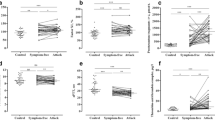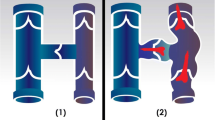Abstract
The relationship between a local hypercoagulable state and primary varicose veins of the lower legs was investigated by measuring the plasma levels of D-dimer (DD) and the thrombin-antithrombin-III complex (TAT) in 122 consecutive patients before treatment, and in 46 patients after surgical intervention and compression sclerotherapy. Elevated levels of DD and TAT were found in 25% and 20%, respectively, of the 122 patients, being significantly elevated in the patients with thrombophlebitis compared to the patients with no dermal symptoms, pigmentation, or stasis dermatitis. There was no significant difference in either parameter among eight groups of patients classified according to their valvular incompetence. The levels of DD and TAT were elevated before treatment in 25% and 20%, respectively, of 45 treated patients, but became significantly reduced after treatment. These results indicate that even though the local hypercoagulable state in varicose veins without thrombophlebitis is too subtle to be detected by systemic parameters such as DD and TAT, a local hypercoagulable state can be detected in a certain proportion of patients with venous stasis by these parameters.
Similar content being viewed by others
References
Skillman JJ (1985) Superficial venous thrombosis and septic thrombophlebitis. In: Jarrett F, Hirsch SA (eds) Vascular surgery of the lower extremity. Mosby, St. Louis, pp 239–243
Leu HJ, Lie JT (1995) Diseases of the veins and lymphatic vessels including angiodysplasia. In: Stehbens WE, Lie JT (eds) Vascular pathology. Chapman and Hall Medical, London, pp 488–516
Bick RL, Ucar K (1992) Hypercoagulability and thrombosis. Hematol Oncol Clin North Am 6:1421–1431
Bitthell TC (1993) Thrombosis and antithrombotic therapy. In: Lee GR, Bithell TC, Foerster J, Athens JW, Lukens JN (eds) Wintrobe's clinical hematology. Lea and Febiger, Malvern, pp 1515–1551
Kakkar VV, Howe CT, Nicolaides AN, Renney JTG, Clarke MB (1970) Deep vein thrombosis of the leg: Is there a “high-risk” group? Am J Surg 120:527–530
Sigel B, Ipsen J, Felix WR (1974) The epidemiology of lower extremity deep venous thrombosis in surgical patients. Ann Surg 179:278–290
Pelzer H, Schwarz A, Heimburger N (1988) Determination of human thrombin-antithrombin III complex in plasma with an enzyme-linked immunosorbent assay. Thromb Haemost 59:101–106
Heaton DC, Billings JD, Hickton CM (1987) Assessment of D dimer assays for the diagnosis of deep vein thrombosis. J Lab Clin Med 110:588–591
Palareti G, Legnai C, Guazzalaca G, Frascaro F, de Rosa F, Fortunato G, Coccheri S (1994) Activation of blood coagulation after abrupt or stepwise withdrawal of oral anticoagulant — a prospective study. Thromb Haemost 72:222–226
Bounameaux H, de Moerloose P, Perrier A, Reber G (1994) Plasma measurement of D-dimer as diagnostic aid in suspected venous thromboembolism: an overview. Thromb Haemost 71:1–6
Tripodi A, Mannucci PM, Chantarangkul V, Bottasso B, Arbini AA, Bella SD, Scorza R (1993) Markers of procoagulant imbalance in patients with localized melanomas and autoimmune disorders. Br J Haematol 84:670–674
Myers KA, Ziegenbein RW, Zeng GH, Matthews PG (1995) Duplex ultrasonography scanning for chronic venous disease: patterns of venous reflux. J Vasc Surg 21:605–612
Sigg K, Zelikovski A (1975) “Quick treatment” — a modified method of sclerotherapy of varicose veins. Vasa 4:73–78
Giansante C, Fiotti N, Cattin L, Giovanni P, Calabrese S (1994) Fibrinogen, D-dimer and thrombin-antithrombin complexes in a random population sample: relationships with other cardiovascular risk factors. Thromb Haemost 71:581–586
Conlan MG, Folsom AR, Finch A, Davis CE, Marcucci G, Sorlie P, Wu KK (1994) Antithrombin III: associations with age, race, sex, and cardiovascular disease risk factors. Thromb Haemost 72:551–556
Fratila A, Rabe E (1993) The differentiated surgical treatment of primary varicosis. Semin Dermatol 12:102–116
Author information
Authors and Affiliations
Rights and permissions
About this article
Cite this article
Ikeda, M., Kambayashi, Ji., Iwamoto, Si. et al. The coagulofibrinolytic state of patients with primary varicose veins of the lower legs. Surg Today 26, 985–989 (1996). https://doi.org/10.1007/BF00309958
Received:
Accepted:
Issue Date:
DOI: https://doi.org/10.1007/BF00309958




